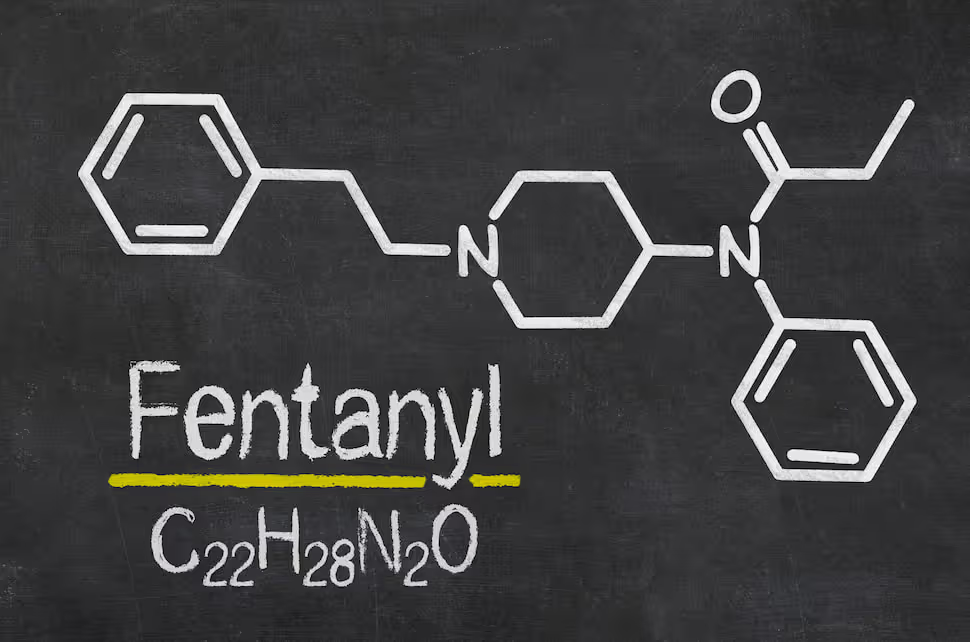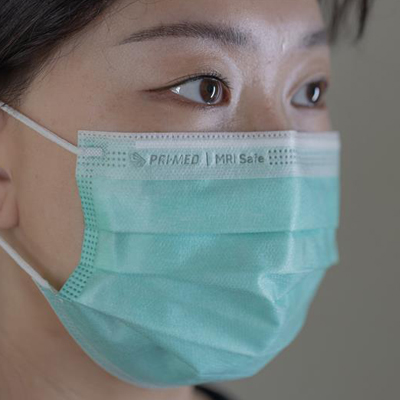Fentanyl exposure risks and the importance of PPE

Disposable gloves, masks, and gowns clearly indicate their protective capabilities to help provide a clear idea of what to expect when encountering traditional medical threat vectors—such as splashing fluids, chemical exposure, bacterial spread, or viral loads. But a rise in fentanyl overdoses and exposure creates a more challenging risk assessment. Testing and labels do not always provide clear guidance on the protection offered against this growing threat.
In this guide, we’ll look at the rise of fentanyl, exposure risks and vectors, fentanyl toxicity symptoms, and how PRIMED’s line up of gloves tested against fentanyl exposure — including our Vital Fentanyl Tested Extended Cuff Nitrile gloves — offer industry-leading protection from this evolving threat for healthcare workers and first-responders.
What is fentanyl?

Fentanyl is the most common form of synthetic opioid today. As governments worldwide fight to reduce pharmaceutical abuse in light of the opioid epidemic, fentanyl has quickly become a common option for illicit use and illegal sales.
It is odorless and tasteless, with 20 to 40 times more potency than heroin and 100 times more potency than morphine. It’s available in various forms, including powders, capsules, tablets, solutions, and rocks. Regardless of its form, analysis by the University of Malta claims that as little as 2 or 3 milligrams of fentanyl can induce respiratory depression and could lead to death.
While it has applications in acute care, much of today’s fentanyl exposure or use starts with black market or illegal acquisition. Health Canada states that 99% of the fentanyl detected in deaths was non-pharmaceutical. Of the more than 6,000 deaths attributed to accidental or unintentional opioid toxicity in 2020, roughly 82% are estimated to involve fentanyl.
Between April and December of 2020,data from nine provinces and territories indicates that Emergency Medical Services responded to nearly 25,000 calls for suspected opioid-related overdoses. Across the same period, more than 4,000 opioid-related poisonings required hospitalization treatment. A figure which Health Canada reports is a 23% increase over the same period the year before. Whether working behind the counter or responding to calls in the field, the risk of fentanyl exposure for healthcare professionals will only continue to increase as the drug gains popularity and circulates throughout the population.
Exposure risks for medical staff and first responders
As fentanyl can enter the body via ingestion, inhalation, injection, or skin contact, this means any situation in which someone might come in contact with a fentanyl user could lead to exposure. This is particularly true of situations such as overdose responses or when searching through, securing, or relocating the belongings of a fentanyl user. Powder forms can quickly go airborne, leading to inhalation or absorption through the eyes.

The problem is complicated further when the person is unaware that the product they are using—such as cocaine or heroin—is laced with fentanyl. This is increasingly popular as it boosts addictive properties while minimizing costs to suppliers. As such, extra diligence is required if fentanyl use is suspected in any way, as even the patient may not be aware of the exposure risks.
Healthcare personnel who should consider illicit fentanyl exposure risks includes but is not limited to nurses, nursing assistants, pharmacists, phlebotomists, physicians, students, technicians, therapists, and trainees. First responders, such as law enforcement officers, firefighters, EMTs, and paramedics, should also consider fentanyl risks and create practical plans to mitigate exposure pathways.
Symptoms of fentanyl exposure and toxicity
The severity and variety of symptoms will vary based on the person, degree of exposure, fentanyl potency, and a range of other variables. However, immediate medical intervention to assess fentanyl exposure risks is recommended if you notice any of the following.
- Slow heart rate
- Sudden drowsiness, severe sleepiness, or dizziness
- Gurgling or snoring sounds
- Blueing of the lips or fingernails
- No response to sternal rubbing
- Slow, shallow breathing
- Clammy, cold skin
- Respiratory arrest
- Nausea or vomiting
- Disorientation
- Seizures
- Loss of consciousness
- Contracted pupils
Using PPE to minimize fentanyl exposure risks
PPE can provide effective protection when dealing with known or suspected fentanyl exposure risks, especially when combined with increased caution and care. Eye protection, such as safety glasses or medical masks with visors, and respiratory protection, such as N95 or P100 masks, can help protect in exposure risk scenarios. Shoe or boot coverings and medical gowns can also prevent moving fentanyl dusts between environments or increase protection coverage in scenarios of extreme risk.

However, for most first responders and healthcare workers, disposable gloves will serve a central role in providing fentanyl exposure protection. It protects from dermal absorption and transfer and allows you to dispose of exposed gloves quickly for added protection. But when dealing with the risks involved, you need to ensure you’re using a glove that offers adequate protection.
Dependable protection by design with PRIMED gloves
PRIMED’s Vital Fentanyl Tested Extended Cuff Nitrile gloves offer affordable pricing, a comfortable design, and superior protection aimed at the unique exposure risks of healthcare professionals and first responders. One of the core features of the glove is the testing to ensure adequate resistance to direct fentanyl exposure and gastric acid which is frequently encountered when dealing with overdoses or nauseous patients.
Testing exposes the glove to the substances in an apparatus that measures whether or not the drug or acid will permeate through the glove’s material. This testing is done as per ASTM D6978 Standard Practice for Assessment of Medical Gloves to Permeation by Chemotherapy Drugs. The amount of time it takes for the gastric acid or fentanyl to reach a minimum threshold concentration is known as the breakthrough time.
All PRIMED gloves tested against fentanyl exposure, such as our Vital Fentanyl Tested Extended Cuff Nitrile gloves, meet the highest breakthrough time rating of greater than 240 minutes. The extended cuff design also provides additional skin coverage. At the same time, the black finish reduces glare to make it easy to spot contamination and avoid the transfer of fentanyl or other environmental pathogens.
Nitrile gloves also reduce the risk of skin irritation or allergic reaction, providing a high quality, dependable option for the entire staff. Many nitrile gloves, such as our Vital Fentanyl Tested Extended Cuff Nitrile gloves, are also accelerator free, reducing Type IV sensitivities (dermatitis). All of this is provided at an affordable price point and backed by the manufacturing and supply prowess of PRIMED to offer an accessible, effective means of protecting first responders and those on the front line of responding to the opioid epidemic.
NOTE: Protection requires proper usage to optimize benefits. Be sure to follow appropriate glove donning and doffing procedures to minimize contamination or exposure risks.
Summary
- Fentanyl toxicity is an increasingly significant portion of opioid accidental or unintentional opioid toxicity throughout Canada and North America.
- As little as 2 or 3 milligrams of fentanyl can lead to respiratory depression and arrest.
- Health Canada reports a 23% increase in opioid poisonings between April and December 2020 compared to the same period the year before.
- Fentanyl is distributed in various forms, including powders, capsules, tablets, solutions, and rocks.
- Healthcare professionals at risk of fentanyl exposure include nurses, nursing assistants, pharmacists, phlebotomists, physicians, students, technicians, therapists, and trainees.
- Law enforcement officers, social workers, firefighters, paramedics, and EMTs should also consider fentanyl exposure risks.
- If you suspect fentanyl exposure or experience fentanyl exposure symptoms, request medical assessment immediately.
- PPE, including medical face masks, single-use gloves, shoe coverings, and eye coverings, is an effective means of preventing fentanyl exposure.
- Gloves must meet testing standards to ensure optimal protection.
- PRIMED’s Vital Fentanyl Tested Extended Cuff Nitrile gloves offer protection under ASTM D6978 Standard Practice for Assessment of Medical Gloves to Permeation by Chemotherapy Drugs for both fentanyl and gastric acid.
- Other glove optimizations include an extended cuff design for increased skin coverage, an anti-glare black finish, and a nitrile base to minimize skin irritation and provide comfort.
PRIMED is a quality leader among PPE providers in Canada and North America. Our extensive selection of gloves, masks, gowns and other high quality PPE help to protect healthcare workers on the frontlines of today’s ever-changing medical landscape. Contact us today to discuss how our Vital Fentanyl Tested Extended Cuff Nitrile gloves can provide effective protection for your staff and patients.
References:
- Government of Canada: Opioid- and Stimulant-related Harms in Canada
- University of Malta Forensic Drug Analysis Laboratory: Fentanyl Safety Recommendations Guide for First Responders
- U.S. Centers for Disease Control and Prevention: Preventing Occupational Exposure to Healthcare Personnel in Hospital and Clinic Settings
- U.S. Centers for Disease Control and Prevention: Fentanyl Emergency Response Card
- Government of Canada: What You Need to Know About Fentanyl Exposure
- Government of Canada: Controlled and Illegal Substances: Fentanyl
- PubMed: Fentanyl and Carfentanil Permeation Through Commercial Disposable Gloves
- Occupational Health & Safety Magazine: Fentanyl Risks Put Focus on Hand Protection in Many Environments
- Harm Reduction Journal: Training To Reduce Emergency Responders’ Perceived Overdose Risk From Contact With Fentanyl: Early Evidence of Success
Related Resources
PRIMED MRI Safe Mask: Safe by Design for Purpose-Built Protection
PRIMED's ASTM Level 3 MRI Safe Masks offer a high-quality, purpose-built solution that merges MRI compatibility with premium protection.

From the Sterile Core to the Decision Table: Elevating the Voice of MDR Professionals
MDR professionals don’t just process products, they influence how they are designed, selected, and standardized.
%20-%20Sterlization%20Wrap%20Display%20(1).jpg)
Protecting with Purpose: The Supply Chain Behind the Mission
PRIMED, resilient through the pandemic, has evolved our supply chain - now stronger, smarter, and ready to meet future challenges with agility and confidence.


